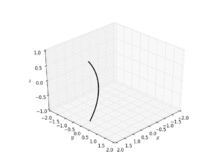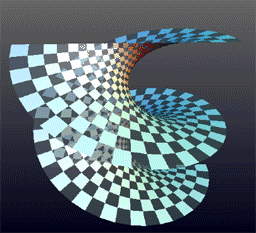Catenoid


In geometry, a catenoid is a type of surface, arising by rotating a catenary curve about an axis (a surface of revolution).[1] It is a minimal surface, meaning that it occupies the least area when bounded by a closed space.[2] It was formally described in 1744 by the mathematician Leonhard Euler.
Soap film attached to twin circular rings will take the shape of a catenoid.[2] Because they are members of the same associate family of surfaces, a catenoid can be bent into a portion of a helicoid, and vice versa.
Geometry
The catenoid was the first non-trivial minimal
Early work on the subject was published also by
The catenoid may be defined by the following parametric equations:
In cylindrical coordinates:
A physical model of a catenoid can be formed by dipping two circular rings into a soap solution and slowly drawing the circles apart.
The catenoid may be also defined approximately by the stretched grid method as a facet 3D model.
Helicoid transformation

Because they are members of the same associate family of surfaces, one can bend a catenoid into a portion of a helicoid without stretching. In other words, one can make a (mostly) continuous and isometric deformation of a catenoid to a portion of the helicoid such that every member of the deformation family is minimal (having a mean curvature of zero). A parametrization of such a deformation is given by the system
- corresponds to a right-handed helicoid,
- corresponds to a catenoid, and
- corresponds to a left-handed helicoid.
References
- ISBN 9783642116988.
- ^ ISBN 9780393040029.
- ISBN 3-76431-424-9.)
{{cite book}}: CS1 maint: multiple names: authors list (link - ^ PMID 16847265.
- ISBN 9781147341744.
- ^ "Catenoid". Wolfram MathWorld. Retrieved 15 January 2017.
Further reading
- Krivoshapko, Sergey; Ivanov, V. N. (2015). "Minimal Surfaces". Encyclopedia of Analytical Surfaces. Springer. ISBN 9783319117737.
External links
- "Catenoid", Encyclopedia of Mathematics, EMS Press, 2001 [1994]
- Catenoid – WebGL model
- Euler's text describing the catenoid at Carnegie Mellon University
- Calculating the surface area of a Catenoid
- Minimal Surface of Revolution







![{\displaystyle (u,v)\in (-\pi ,\pi ]\times (-\infty ,\infty )}](https://wikimedia.org/api/rest_v1/media/math/render/svg/69bd6d31446bbbbdb601db5ced84afb267ec09fb)




